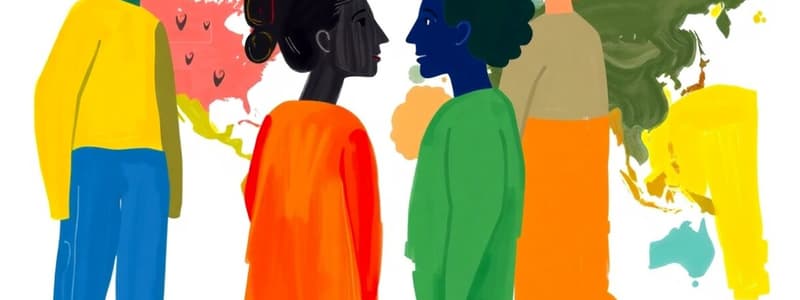Podcast
Questions and Answers
Which of the following best describes the primary challenge faced by the Global Integration Team at GlobalCare Ltd.?
Which of the following best describes the primary challenge faced by the Global Integration Team at GlobalCare Ltd.?
- Conflicting cultural norms and communication styles. (correct)
- Lack of technological resources for system design.
- Absence of clear leadership within the team.
- Insufficient marketing budget for the OneHealth platform.
Based on the provided information, how does Haruto's communication style primarily differ from Claire's?
Based on the provided information, how does Haruto's communication style primarily differ from Claire's?
- Haruto focuses on personal goals, while Claire focuses on group goals.
- Haruto prefers direct and informal communication, while Claire is polite and consensus-driven.
- Haruto values consensus and avoids direct disagreement, while Claire is straight-talking and informal. (correct)
- Haruto is calm and structured, while Claire is relationship-oriented and expressive.
According to Hofstede's dimensions, which characteristic aligns with Haruto's tendency to value seniority?
According to Hofstede's dimensions, which characteristic aligns with Haruto's tendency to value seniority?
- Low Uncertainty Avoidance
- Short-Term Orientation
- Individualism
- High Power Distance (correct)
Which of the following actions would be most effective for Maria to take during the workshop to address the team's cultural differences?
Which of the following actions would be most effective for Maria to take during the workshop to address the team's cultural differences?
Based on their described frustrations, which pair of team members is most likely to experience conflict due to differing communication styles?
Based on their described frustrations, which pair of team members is most likely to experience conflict due to differing communication styles?
Which of Hofstede's dimensions is most relevant to understanding Elsa's preference for plans and structure?
Which of Hofstede's dimensions is most relevant to understanding Elsa's preference for plans and structure?
What does the case suggest is the potential outcome of ignoring cultural differences within a global team?
What does the case suggest is the potential outcome of ignoring cultural differences within a global team?
How might Tunde's 'relationship-oriented' style manifest in a team setting?
How might Tunde's 'relationship-oriented' style manifest in a team setting?
In a team discussion, how might Haruto's cultural background influence his response to a suggestion he disagrees with?
In a team discussion, how might Haruto's cultural background influence his response to a suggestion he disagrees with?
Which of the following scenarios best illustrates a conflict arising from differing perspectives on 'long vs short-term' orientation?
Which of the following scenarios best illustrates a conflict arising from differing perspectives on 'long vs short-term' orientation?
If the OneHealth platform rollout is behind schedule, how might Claire's 'straight-talking' style be perceived by Haruto?
If the OneHealth platform rollout is behind schedule, how might Claire's 'straight-talking' style be perceived by Haruto?
According to the mini-theory guide, which team member is most likely to prefer adapting to changing plans?
According to the mini-theory guide, which team member is most likely to prefer adapting to changing plans?
Based on the information provided, which team member best represents a low-context communication style?
Based on the information provided, which team member best represents a low-context communication style?
Which action exemplifies Maria acting as a 'neutral facilitator' during a team conflict?
Which action exemplifies Maria acting as a 'neutral facilitator' during a team conflict?
How might Elsa's value for equality influence her behavior during a team meeting?
How might Elsa's value for equality influence her behavior during a team meeting?
What is a potential downside of Tunde's adaptable style in a project with strict deadlines?
What is a potential downside of Tunde's adaptable style in a project with strict deadlines?
How does the case scenario portray the relationship between individual personality and cultural background?
How does the case scenario portray the relationship between individual personality and cultural background?
Which cultural dimension is most closely related to the level of importance a society places on personal achievement versus group harmony?
Which cultural dimension is most closely related to the level of importance a society places on personal achievement versus group harmony?
In the context of the GlobalCare Ltd. team, what does 'culture' primarily encompass?
In the context of the GlobalCare Ltd. team, what does 'culture' primarily encompass?
How could Maria use the 'Activity: Take the Cultural Dimensions Test' effectively during the workshop?
How could Maria use the 'Activity: Take the Cultural Dimensions Test' effectively during the workshop?
Flashcards
Global Integration Team
Global Integration Team
A team comprised of members from different countries working together.
Culture
Culture
Shared values, beliefs, and behaviors of a group or society.
High-context culture
High-context culture
Communication relies on tone, body language, and social cues.
Low-context culture
Low-context culture
Signup and view all the flashcards
Individualism
Individualism
Signup and view all the flashcards
Collectivism
Collectivism
Signup and view all the flashcards
Power Distance
Power Distance
Signup and view all the flashcards
Uncertainty Avoidance
Uncertainty Avoidance
Signup and view all the flashcards
Power Distance (Hofstede)
Power Distance (Hofstede)
Signup and view all the flashcards
Individualism/Collectivism (Hofstede)
Individualism/Collectivism (Hofstede)
Signup and view all the flashcards
Uncertainty Avoidance (Hofstede)
Uncertainty Avoidance (Hofstede)
Signup and view all the flashcards
Masculinity/Femininity (Hofstede)
Masculinity/Femininity (Hofstede)
Signup and view all the flashcards
Long vs Short-Term (Hofstede)
Long vs Short-Term (Hofstede)
Signup and view all the flashcards
Indulgence vs Restraint
Indulgence vs Restraint
Signup and view all the flashcards
Study Notes
GlobalCare Ltd Scenario
- GlobalCare Ltd, a UK-based healthcare technology company, launched its OneHealth platform in Japan, Sweden, Nigeria, and the UK due to growing demand across borders.
- A cross-cultural "Global Integration Team" was assembled to collaborate on system design, marketing, operations, and strategy for a smooth rollout.
- Tensions arise due to team members operating from different "rulebooks," leading to misunderstandings and stalled progress.
- Maria, the UK-based HR Partner, organizes a two-day in-person team-building workshop in London to address these issues.
Team Member Insights
- Claire (UK – Team Lead): Straight-talking, informal, and fast-paced, believing in direct communication to save time and is frustrated by Haruto's indirectness.
- Haruto (Japan – Systems Manager): Polite, consensus-driven, avoids direct disagreement, considers it disrespectful to openly challenge someone, and finds Claire's decision-making rushed.
- Elsa (Sweden – Operations Director): Calm, structured, values equality and process, believes everyone should speak and follow the plan, and is frustrated by Tunde's deviation from timelines.
- Tunde (Nigeria – Marketing Lead): Relationship-oriented, expressive, adaptable, believes work flows when people trust each other, and finds Elsa too rigid.
- Maria (UK – HR Partner): Serves as a neutral facilitator, aiming to help the team understand cultural differences as the root of their issues.
Culture in Action
- Maria suggests that the team may be speaking different languages despite being professionals due to their diverse cultural backgrounds.
- She emphasizes that culture shapes how individuals think, work, and communicate.
Hofstede’s Dimensions (Simplified)
- Power Distance: Attitudes toward hierarchy and authority can vary, with some cultures valuing seniority (Haruto) while others do not (Elsa).
- Individualism/Collectivism: Cultures differ in their focus on individual vs group goals, with some prioritizing "I" (Claire) and others prioritizing "we" (Haruto).
- Uncertainty Avoidance: Preferences for structure vs flexibility can vary, with some preferring detailed plans (Elsa) and others adapting as needed (Tunde).
- Masculinity/Femininity: Work cultures can be competitive or collaborative, with some being more masculine (UK) and others more feminine (Sweden).
- Long vs Short-Term: Focus can be placed on planning for the future (Haruto) or focusing on quick wins.
- Indulgence vs Restraint: Cultures differ in their expression of enjoyment, with some being indulgent (Tunde) and others restrained (Haruto).
Cultural Dimensions Test & Reflection
- Participants are provided with a link to a cultural dimensions test to identify their own cultural tendencies
- Reflection prompts are included to allow team members to consider how the results might influence their interactions and understanding within a multicultural team
Key Terms
- Culture: Shared values, beliefs, and behaviours of a group or society.
- High-context culture: Communication relies on tone, body language, and social cues (e.g., Japan).
- Low-context culture: Communication is direct and explicit (e.g., UK, USA).
- Individualism: Focus on personal goals and autonomy.
- Collectivism: Focus on group goals and loyalty.
- Power Distance: How equally or unequally power is accepted within a society.
- Uncertainty Avoidance: How comfortable a society is with ambiguity and change.
Studying That Suits You
Use AI to generate personalized quizzes and flashcards to suit your learning preferences.




